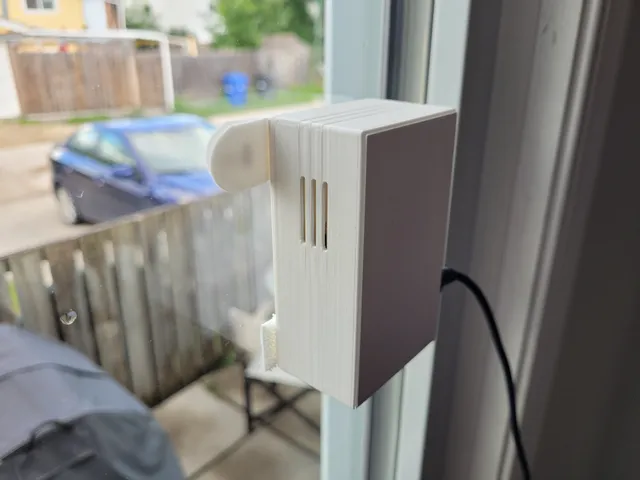
Raspberry Pi timelapse camera case
prusaprinters
This is my setup for a window-mounted Raspberry Pi Zero 2 W timelapse camera.The hardware assembly (Raspberry Pi & camera mount) is attached to the window mount with screws, allowing you to tinker with the hardware and re-mount the camera in exactly the same spot, to prevent the timelapse from shifting.Clone this Git repo for the scripts mentioned below:capture.sh – Uses libcamera to take a picture, using date/time format file namegenerate-timelapse.sh – Uses ffmpeg to combine images into a timelapse video, including a blend showing a comparison between two imagesDemosHere's a demo video with the HQ camera and wide angle lens, taking a picture every minute from 5am–10pm. Here's a video demonstrating the blend effect, at the end. This was made using a mobile phone camera set to take a picture every day. Since it wasn't window-mounted, it also demonstrates the shifting that this setup fixes! What you'll needItemNotesRaspberry Pi Zero 2 WA Raspberry Pi Zero W should work, but I haven't tested with one.SD CardShould be large enough to store some pictures, but I'd recommend backing them up regularly. Using the HQ Camera, 365 pictures takes up ~835MB.Raspberry Pi CameraOptions include:Camera Module 2 or a similar sized module - I tested with the ArduCam 64MP Autofocus CameraHQ Camera & Wide Angle LensCamera ribbon~8cm longLook for one with a wide and a thin end like this for the Pi Zero.Standoffs, compatible screws & nutsFor the Camera Module:(4) M2 x 6mm(4) M2.5 x 10mmFor the HQ Camera:(4) M2.5 x 6mm(4) M2.5 x 10mmM3 Screws (4)8–12mm longCommand StripsOr some other adhesive. The 3M picture hanging strips have worked well for me.Everything for the Camera Module:Everything for the HQ Camera: Camera Sample VideosSample video using the HQ camera. I prefer the results from this camera, and found that the auto-exposure worked better. There can be some chromatic aberration near the corners, but it isn't noticeable in this video.Sample video using the 64MP Autofocus camera. SetupInstall Raspberry Pi OSI use the lite (command line only) version, as it uses less resources, and I only access my camera remotely. If you aren't comfortable using the command line, the full version should work just fine.Use the official Raspberry Pi Imager to install Raspberry Pi OS Lite onto your SD card. This will erase everything from the card.Click the gear icon in the bottom-right, and set the following options:Enable SSHUse password authenticationSet username and passwordSet your username and password hereConfigure wireless LANFill in your local network name and password, and your countrySet locale settings Capture scriptCheck out the official Raspberry Pi Camera Documentation for details on other camera settings.Create a file named capture.sh – see snippet below, or clone this repoCreate the timelapse folder using mkdir timelapseMake the script executable using chmod +x capture.shTest the script by running ./capture.sh – it should take a picture and drop it in the new timelapse folder!capture.sh#!/bin/bash libcamera-still --nopreview -o /home/pi/timelapse/$(date '+%Y%m%d_%H%M%S').jpgTaking pictures on a scheduleWe can use cron to automatically run the capture script on a schedule. This could be every minute between 5am and 9pm, every day at a certain time, or any other interval. If you're not familiar with cron, check out crontab guru for some help.The following takes a picture every day at noon, and stores the latest debug output in output.txt:0 12 * * * /home/pi/capture.sh > /home/pi/output.txt 2>&1 AssemblyInsert nuts into slots on plate, screw in standoffs.Connect camera ribbon to the Raspberry Pi and the camera – the shiny contacts should be facing the board on both components.Attach camera and Raspberry Pi to the plate using standoff screws.Attach assembly to the “Front” piece using M3 screws.Snap on the “Shell” piece. Making a videoTo put the images together into a video, you can use ffmpeg, a command-line video utility. You could do this step on your Raspberry Pi, but it will be very slow. Instead, I recommend transferring the images to a separate computer and running the script there.This Git repo includes a generate-timelapse.sh script – edit the variables at the top to set some options, then run from your terminal using ./generate-timelapse.sh.# Output options FRAMERATE=24 # Number of frames per second WIDTH=2048 HEIGHT=1536 ENABLE_BLEND=true # Adds transition at the end of the timelapse, to compare two images BLEND_LENGTH=2 # Length in seconds of the blend transition BLEND_PAUSE=1 # How long to sit on images between blends BLEND_TOTAL_LENGTH=$((BLEND_LENGTH + BLEND_PAUSE)) # Length in seconds of the blend clips – will stay on the last frame until time's up # Input options INPUT_GLOB=./timelapse/*.jpg # Input image name pattern TIMELAPSE_NAME=./timelapse/timelapse.mp4 # Output timelapse name FINAL_NAME=./timelapse/timelapse_final.mp4 # Final output name, with blends # Blend options - only needed if ENABLE_BLEND is true BLEND_IMG_START=./timelapse/20220729_090001.jpg # "Before" image BLEND_IMG_END=./timelapse/20220729_171901.jpg # "After" image
With this file you will be able to print Raspberry Pi timelapse camera case with your 3D printer. Click on the button and save the file on your computer to work, edit or customize your design. You can also find more 3D designs for printers on Raspberry Pi timelapse camera case.
